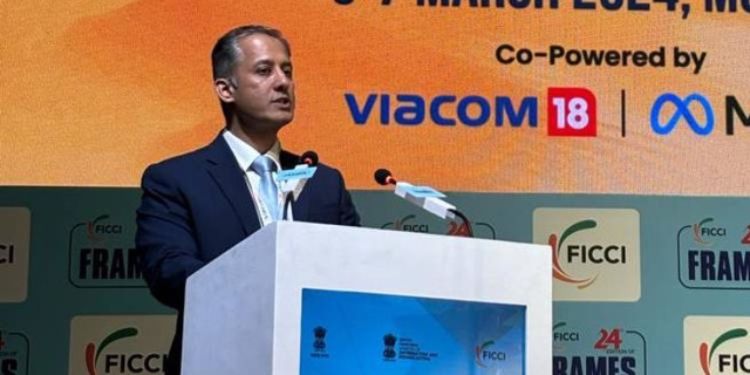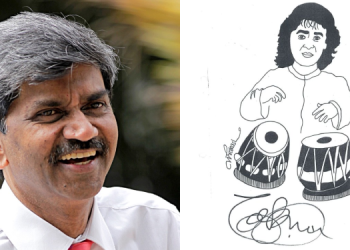In his introductory speech at FICCI Frames 2024, Kevin Vaz, CEO- Broadcast entertainment at Viacom18 reflected on the Media & Entertainment sector, both on a global scale and within the Indian context.
“It’s evident that we stand at a crossroad of unprecedented growth and transformation. Globally, the industry is witnessing remarkable shifts, with digital innovations reshaping consumption patterns and content creation dynamics. The Indian M&E sector stands out for its unique blend of tradition and innovation – where tech supported entertainment television channels, OTT platforms, AI newsreader led news channels, hardcopy broadsheets, marquee films and short form reels – all not only co-exist but are growing,” Vaz said.
In 2023, our industry witnessed a remarkable era of content creation, with over 200,000 hours of content produced annually. Indian content has transcended international boundaries, captivating audiences in more than 160 countries and topping streaming charts on global platforms.
In 2023, Indian content bagged not one but two Oscars for the best song and the best documentary respectively. Indian music talent has bagged 3 Grammys recently. 2 Indians (Vir Das and Ekta Kapoor) won the prestigious International Emmy’s awards. According to Vaz the shift indicates a new era where local flavors and stories are embraced by audiences worldwide, showcasing the universal appeal of Indian stories and our storytelling.
Vaz later touched upon the topic of integration of digital technologies in the Indian M&E industry which is at a scale without parallel amongst the comity of nations.
“Driven by accessible and affordable internet, with Commercial 5G services rollout propelling the growth of India M&E, we must recognise the virtuous cycle of investments in creativity that drive the expansion of affordable internet in India. We can be proud of the fact that Indian companies, Indian creators, Indian producers, are at the forefront of the digital content revolution, be it in films, music or gaming,” he said.
Vaz underlined that the platforms like JioCinema have revolutionized sports viewership in India, offering accessible and affordable access to live matches like the IPL, which goes to show the importance of internet accessibility in driving the growth of the M&E industry.
“Unlike other industries, M&E has caught the digital transformation wave early and stand ready to reap the benefits with supportive developments in the all-critical triad of infrastructure readiness, consumer market growth, and enabling public policies,” Vaz added.
According to him, the surge in digital media is forecasted to propel the M&E sector’s growth to a 10-pc annual rate, reaching Rs 3 trillion by 2026.
“Technological innovations have brought with it a paradigm shifts in consumer preferences. Consumers now demand more personalised, interactive, and immersive content. This creates another facet to the growth of the entire digital media segment, including online curated content, digital advertising, online gaming, to name a few. Each of us need to reflect on how these preferences will change the way we think about the future of M&E, and the business models that are most suited to respond. To navigate the future, all of us at various intersections of the industry need to adopt innovative strategies and create engaging content across multiple platforms, leverage big data analytics, collaborate with global partners, and explore new revenue streams,” Vaz said.
Despite the digital boom, traditional media in India is also experiencing a steady growth, showcasing India’s diverse media consumption habits. While this might appear to be a paradox when viewed through a singular global lens, this is the truth of India – a market of AND, not OR.
Speaking about the journey of M&E industry in 2023 Vaz said that it becomes clear that it was a year marked by both challenges and triumphs.
According to him, the first half was subdued, with modest growth rates across various segments of the industry. However, as raw material prices stabilized and marquee events like the ICC Cricket World Cup and Assembly Elections unfolded, we witnessed a significant uptick in the second half. And while the M&E industry is estimated to grow at 10 pc CAGR through the next few years led by digital, traditional mediums such as Television and print are also poised to grow.
“This growth underscores the enduring appeal of linear TV, particularly among established advertisers who value its unmatched brand-building capabilities at scale. It’s essential to acknowledge the continued significance of traditional media, including television, print, and outdoor advertising, in reaching diverse audience segments, especially in regional markets,” he noted.
The Road Ahead:
“The road ahead for the industry is brimming with possibilities and challenges alike,” Vaz noted.
“The integration of artificial intelligence promises to reshape the landscape of content creation, distribution, and consumption. Particularly generative AI, which is now an inexorable part of M&E supply chains. Advances in generative AI, while still relatively nascent, have produced an explosion of possibilities in the creative sector. It has ushered in a new dimension to the creative process, allowing the industry to explore uncharted territories of creativity and push the boundaries of productivity,” he further added.
As AI technologies continue to evolve, they offer unprecedented opportunities for personalized experiences and targeted advertising. However, this next-gen transformation also presents challenges such as data privacy concerns, reskilling and the need for ethical considerations – concerns that the industry and government together need to explore and address.
Vaz also underlined the fact that the industry must also address the pressing need for stronger intellectual property rights protection to safeguard the integrity of the creative ecosystem. “The proliferation of digital platforms and content creation tools has exponentially increased the avenues for creative expression, yet it has also heightened the risk of copyright infringement. Strengthening our IPR laws is essential to foster a conducive environment for innovation and creativity while ensuring fair compensation for content creators. The National Intellectual Rights (IPR) Policy, established in 2016, is due for review. This presents an occasion for all of us to engage on how we think about monetisation, commercialisation of content as well as the protections required for it, in a fast-evolving technological environment,” he noted.
Vaz reiterated that the road ahead encompasses both opportunities and challenges in equal measure.
“As we navigate this complex landscape, as stakeholders of this vibrant sector, we must all remember that at the heart of it, our industry is about our consumers in a very human sense – their emotions, relationships, talents – their stories. All of us here today are simply facilitators – connecting stories to audiences and audiences to stories,” he concluded.

















